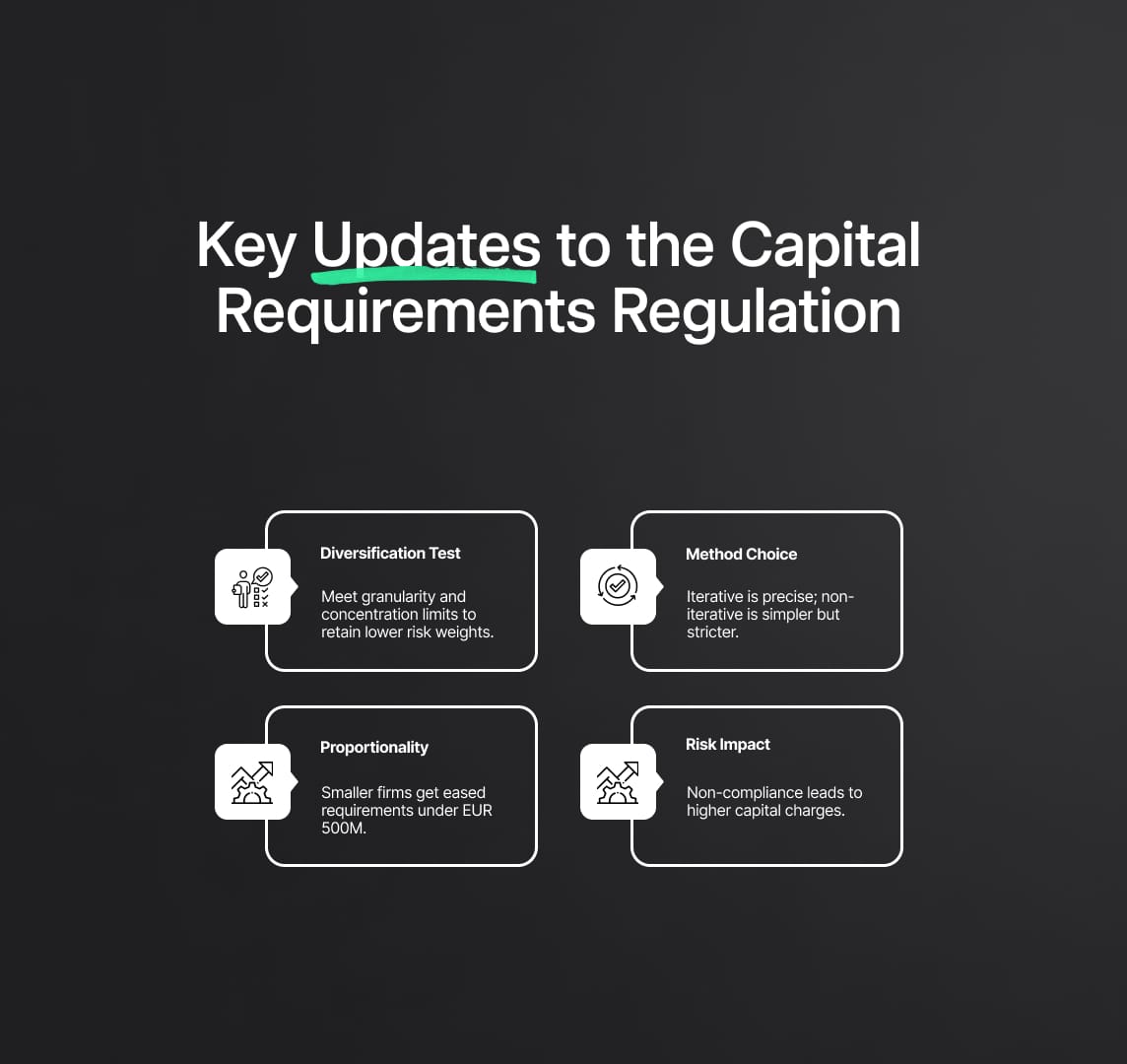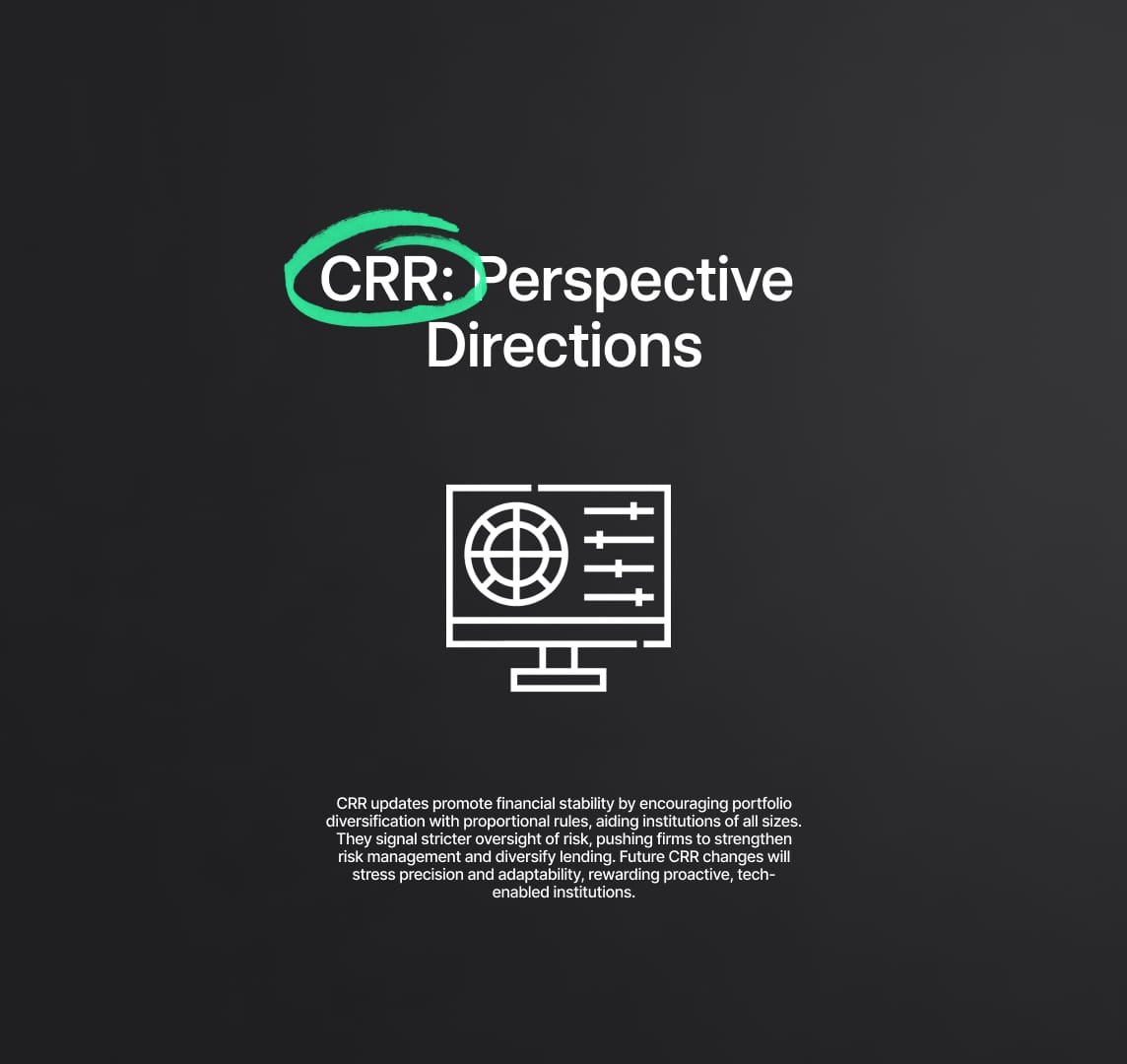CRR: Retail Portfolio Diversification
EBA updates the Capital Requirements Regulation (CRR) to enforce stricter diversification and risk management measures, enhancing financial resilience across the EU.

The latest updates to the Capital Requirements Regulation (CRR), published on November 12, 2024, introduce significant changes to retail exposure diversification. These changes, developed by the European Banking Authority (EBA) under the mandate of Article 123(1) of the CRR, aim to enhance financial stability across the European Union. The updates ensure that financial institutions manage their retail portfolios with adequate diversification, thereby reducing associated risks and aligning with the regulatory goals of prudence and proportionality.
Source
[1]

[2]

What is Capital Requirements Regulation (CRR)?
The Capital Requirements Regulation (CRR) is a critical component of the European Union's regulatory framework for banks and financial institutions. It sets out rules governing capital adequacy, risk management, and reporting requirements to ensure the stability and resilience of the financial system. By mandating that institutions maintain sufficient capital relative to their risk exposures, the CRR aims to safeguard against financial crises and promote confidence in the banking sector.
CRR: Who is impacted?
The latest updates to the CRR will affect a broad spectrum of financial institutions, particularly those managing retail lending portfolios. This includes banks, credit institutions, and other entities governed by CRR that must comply with rules on portfolio diversification to qualify for preferential risk weights. Smaller institutions with less diversified portfolios are especially impacted, as they may need to make operational adjustments to meet the new requirements. At the same time, larger institutions, while often better positioned to comply, must also refine their risk management practices to align with the updated diversification standards. The changes aim to create a level playing field across institutions of all sizes while enhancing financial stability across the EU.

Key Updates to the Capital Requirements Regulation (CRR)
1.How to Implement Diversification Tests for Retail Portfolios
One of the most critical updates to the Capital Requirements Regulation (CRR) is the introduction of a detailed diversification test for retail portfolios. This test ensures that financial institutions maintain a level of portfolio granularity necessary to qualify for preferential risk weights under the regulation. The diversification test is a direct response to Article 123(1) of the CRR, which requires retail exposures to represent a significant number of similar exposures, reducing the overall risks associated with the portfolio.
The test is built around two key thresholds:
- Granularity Threshold: No single retail exposure (or exposures aggregated at the level of a group of connected clients, GCCs) should exceed 0.2% of the total value of the retail portfolio.
- Portfolio Concentration Threshold: The sum of retail exposures exceeding the 0.2% granularity threshold must not constitute more than 10% of the total retail portfolio.
Institutions must perform this test iteratively, identifying exposures above the thresholds, removing them, and recalculating the portfolio until the remaining exposures comply with the diversification requirements.
Key Regulatory Details:
- Scope of Assessment: The test applies to retail exposures as defined under CRR Article 123(1) points (a), (b), and (d), excluding defaulted exposures per CRR Article 123(2).
- Group of Connected Clients (GCCs): Institutions must aggregate exposures at the GCC level to prevent underestimating the concentration of risks.
- Application Level: The test is performed either at the individual institution level or at the consolidated level, depending on the scope of minimum own funds calculations.
- Excluded Exposures: Any exposure exceeding the thresholds must be excluded from the calculation of preferential risk weights.
Impacts:
- Operational Adjustments: Institutions with highly concentrated portfolios may need significant structural changes to meet the diversification thresholds. This may involve recalibrating lending practices or limiting exposure sizes within the retail portfolio.
- Smaller Institutions: Resource constraints may make it challenging for smaller institutions to adopt the complex iterative process without external support or system enhancements.
- Larger Institutions: Despite having more diversified portfolios, larger institutions may still need to upgrade systems to automate exposure tracking and ensure compliance with the thresholds.
What to Do:
- Financial institutions should adopt robust portfolio risk management systems capable of continuously monitoring exposure granularity.
- Regular portfolio reviews and dynamic adjustments are essential to maintain compliance.
- Institutions must integrate automated tools to identify exposures exceeding thresholds and streamline the iterative recalculation process.
2. Choosing Between Iterative and Non-Iterative Approaches
To ensure that institutions can implement the diversification test effectively, the guidelines offer two methods for calculating compliance: the iterative approach and the non-iterative approach. These approaches differ in complexity and the strictness of their thresholds.
Iterative Approach:
- Institutions assess their portfolio and identify exposures exceeding the 0.2% granularity threshold.
- Exposures above this threshold are removed, and the test is repeated using the recalculated portfolio value.
- The process continues iteratively until the portfolio complies with the 10% concentration threshold.
Non-Iterative Approach:
- The granularity threshold is applied to the original portfolio without removing exposures exceeding 0.2%.
- To compensate for its simplicity, the concentration threshold is stricter, requiring that exposures exceeding the granularity threshold must not constitute more than 5% of the portfolio.
Key Regulatory Details:
- The iterative method provides a more precise representation of portfolio diversification but requires additional calculations and resources.
- The non-iterative approach simplifies compliance checks but demands a higher level of granularity in the original portfolio.
Impacts:
- Iterative Method: This method promotes a higher standard of granularity and reduces risks more effectively but increases operational complexity. It is more suited for larger institutions with the resources to handle the iterative calculations.
- Non-Iterative Method: While simpler, this approach requires stricter initial compliance, making it more challenging for institutions with concentrated portfolios to qualify for preferential risk weights.
What to Do:
- Institutions must evaluate their portfolio characteristics, operational capacity, and resource availability to choose the most suitable approach.
- Larger institutions may prefer the iterative approach for its precision, while smaller entities might opt for the non-iterative method due to its simplicity.
3. Leveraging Proportionality for Smaller Institutions
Recognizing the diversity of institutions regulated under the CRR, the guidelines emphasize the principle of proportionality. Smaller institutions with less complex portfolios, especially those with retail portfolios valued under EUR 500 million, are granted more lenient diversification assessment criteria.
Key Regulatory Details:
- Institutions with smaller portfolios are not required to adhere to the full stringency of the diversification test applicable to larger institutions.
- The EBA ensures that the proportionality measures align with the prudential objectives of the CRR while minimizing operational burdens for smaller entities.
Impacts:
- Smaller Institutions: These entities gain operational flexibility, reducing the compliance costs and burdens associated with the diversification test.
- Larger Institutions: Larger institutions are held to the standard thresholds and must implement the full scope of diversification assessments.
What to Do:
- Smaller institutions should optimize their resource allocation to leverage the proportionality measures.
- Larger institutions must prepare for stricter compliance by adopting advanced systems to manage more extensive and diverse portfolios.
4. Managing Risk Weight Adjustments for Non-Diversified Exposures
The updated guidelines introduce stricter consequences for institutions that fail to comply with diversification requirements. Retail exposures that do not meet the diversification test will no longer qualify for preferential risk weights and will instead be subject to higher capital charges.
Key Regulatory Details:
- Exposures failing the diversification test must be assigned a 100% risk weight for natural persons or treated as corporate exposures for SMEs.
- This adjustment aligns the capital requirements with the heightened risks associated with concentrated portfolios.
Impacts:
- Increased Capital Costs: Institutions with non-diversified portfolios face higher capital requirements, directly impacting profitability and potentially reducing lending capacity.
- Incentive for Compliance: The stricter risk weights encourage institutions to diversify their portfolios to benefit from the 75% preferential risk weight.
What to Do:
- Institutions should prioritize diversification strategies to retain preferential risk classifications.
- Regular evaluations of exposure weights and dynamic portfolio adjustments are crucial to avoid higher capital charges.

CRR: Perspective Directions
The updates to the Capital Requirements Regulation (CRR) reflect the EBA's commitment to fostering financial stability through enhanced portfolio diversification. By introducing proportional measures, the regulation balances prudential objectives with operational feasibility for institutions of varying sizes.
Strategically, these updates signal a shift toward greater regulatory oversight of portfolio granularity and risk distribution. Institutions must embrace advanced risk management frameworks, implement robust compliance monitoring tools, and adapt lending practices to diversify portfolios effectively.
Looking ahead, the CRR framework will likely continue to evolve, emphasizing precision in risk assessment and the integration of proportionality into broader regulatory structures. Institutions that proactively align with these trends by investing in digital risk management solutions and adaptive compliance strategies will position themselves for sustainable growth in a highly regulated financial ecosystem.
Reduce your
compliance risks



